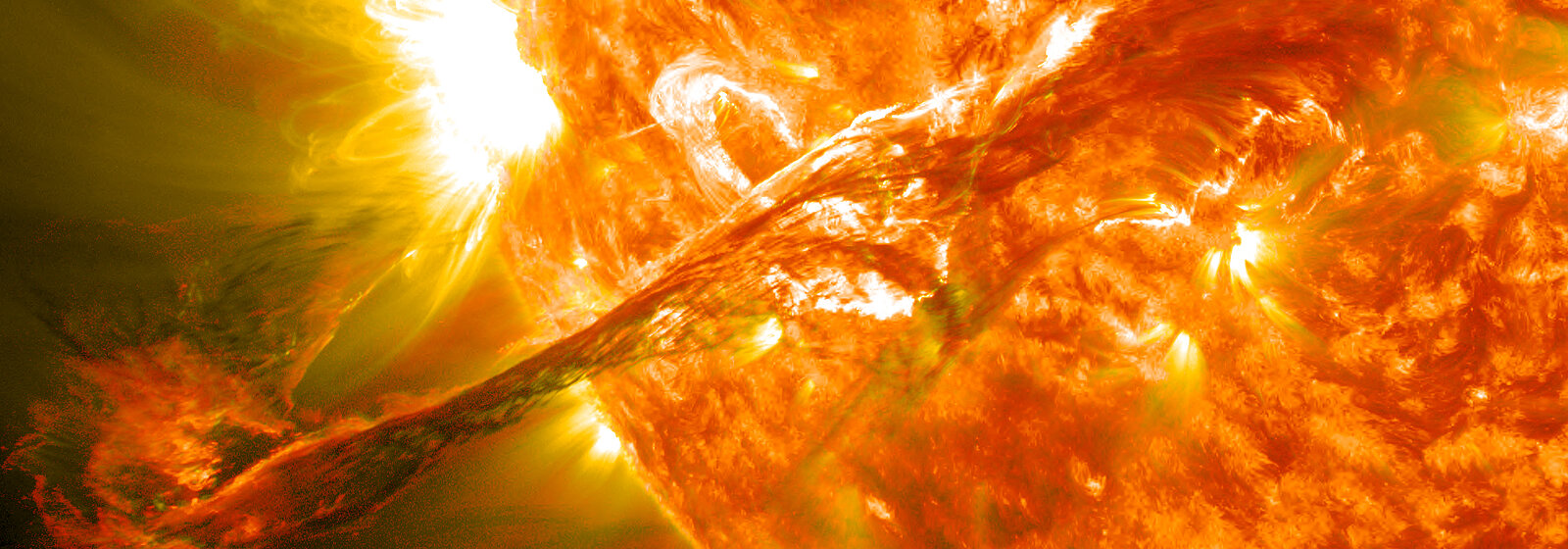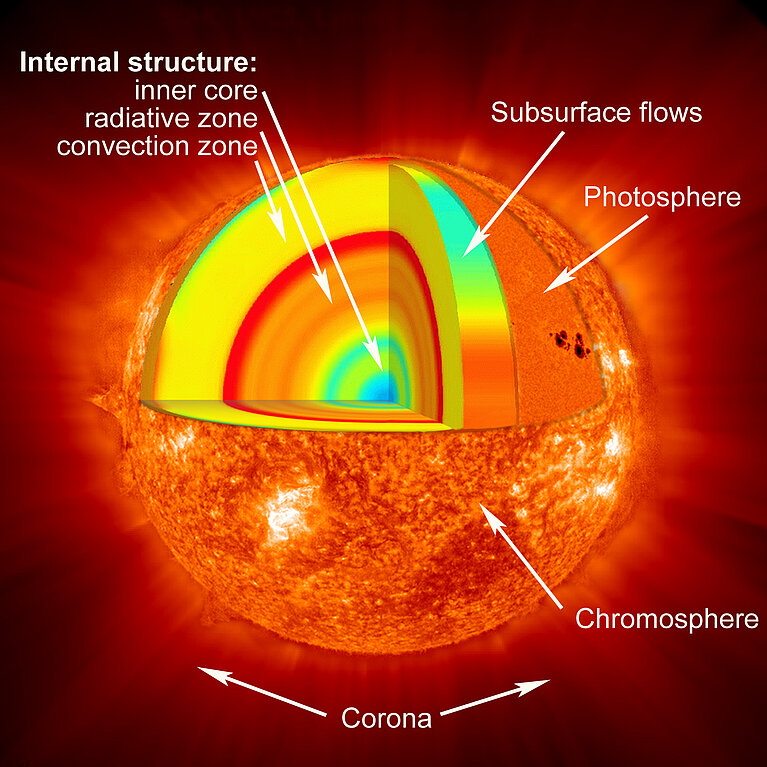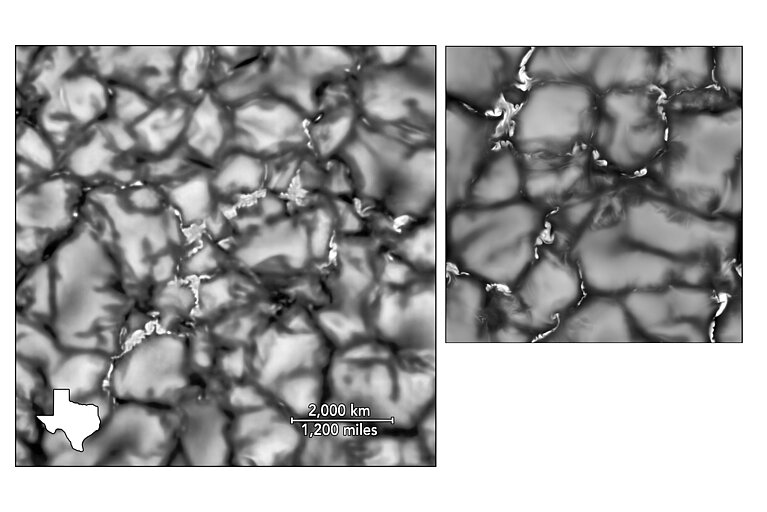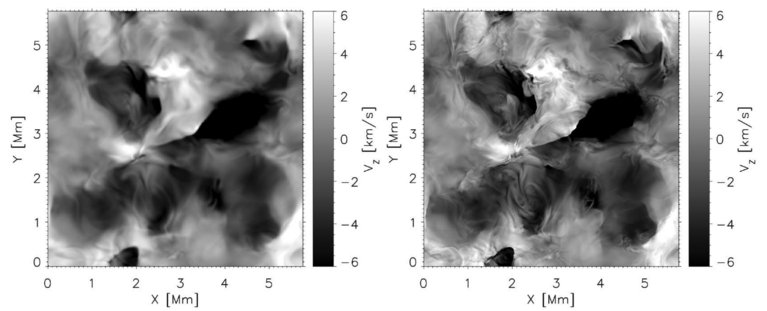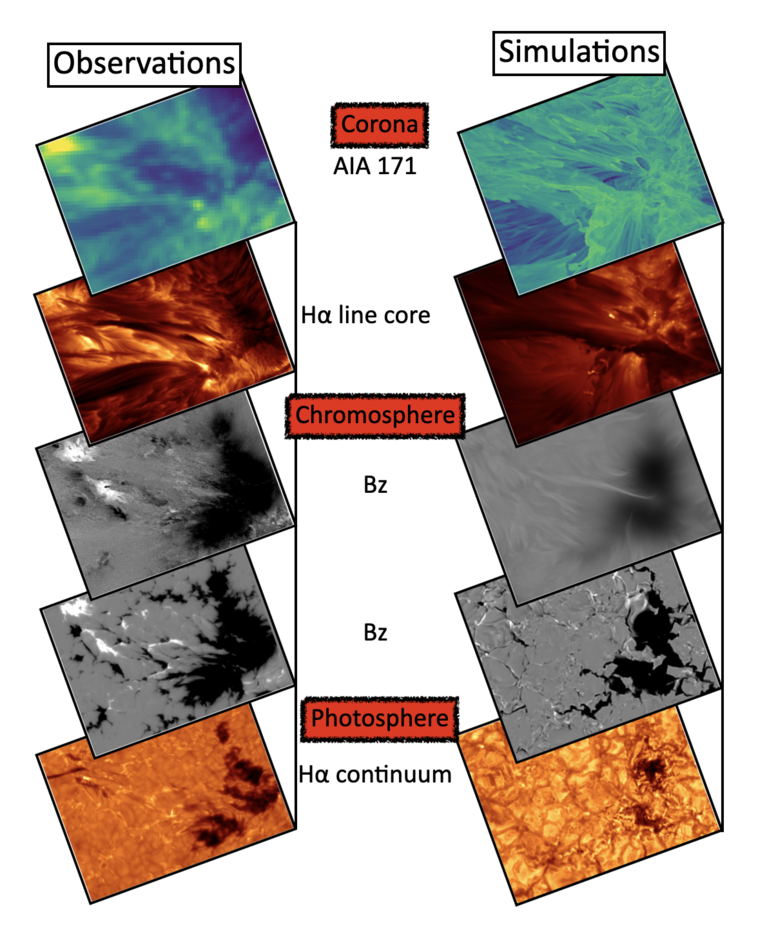May 30, 2023 - by Santina Russo
The Sun is a complicated thing. “Imagine a gas ball formed of a plasma of charged particles, with an inner core consisting of a nuclear fusion reactor that emits immense heat surrounded by several layers of turbulent plasma, all with completely different characteristics — the photosphere layer emitting radiation and thereby loosing energy which makes it comparatively cool, others gaining energy again becoming incredibly hot,” explains Oskar Steiner. “And permeating it all, there are magnetic fields formed by the charged particles, which, in turn, impact the particles, which again create different magnetic fields — an everlasting and complex cycle.”
SOLARNET: A focused effort
As a senior researcher at the Leibniz Institute for Solar Physics in Freiburg, Germany, as well as a group leader at IRSOL, an institute devoted to solar physics associated with Università della Svizzera Italiana USI in the Swiss canton Ticino, Steiner is one of the leading solar physicists in Europe. Among other things, he investigates solar processes using simulations on supercomputers. He is also a member of the time allocation committee for access to computing time on CSCS’s supercomputer “Piz Daint” within the SOLARNET program.
SOLARNET is a coordinated effort in solar physics that promotes the interaction between solar physics researchers at different institutes. For the last three years, it has provided European research infrastructures to a community of more than 600 solar physicists in Europe. Along with observatories, such as the Swedish Solar Telescope on La Palma, the German GREGOR telescope on Tenerife, or the Zurich Imaging Polarimeter (ZIMPOL) located at IRSOL in Locarno, SOLARNET also granted privileged access to “Piz Daint” via a collaboration between SOLARNET partner USI represented by IRSOL and CSCS, thereby enabling high-fidelity simulations to investigate solar processes.
“One limitation that we have with telescopes is that we can only see the Sun’s surface and analyse the emitted light,” explains Steiner. “Using simulations, however, we can reproduce the solar processes in three-dimensional space.” In simulations, the scientists can adjust parameters or add physics to identify the physical processes that result in the observed data, and to gain knowledge on the Sun’s magnetic fields and the energy transfer from the core out to the corona.
As a focused effort, SOLARNET started at the beginning of 2020 and will end in July 2023. As Oskar Steiner recounts, privileged access to “Piz Daint” within the program took some time to gain momentum. But with increasing experience, things improved, and by the fourth call, allocations were overbooked three-fold. “We see now that high-quality publications are coming out, and we have received a lot of positive feedback on ‘Piz Daint’ and the CSCS services,” Steiner added.
Neutral pigheads in the Sun
Among the successful scientists was Elena Khomenko, a group leader at the Instituto de Astrofísica de Canarias. She underlined how smooth it was for her group to work with “Piz Daint” for the first time, especially the system for parallel downloading provided by CSCS that made data transfer extremely quick.
In addition to other things, Khomenko investigates the Sun’s chromosphere layer, which is as complex as it is interesting. In fact, one of the most thrilling riddles in solar physics is the identification of the mechanisms that heat the solar chromosphere to around 20,000 Kelvin — and the corona to several million Kelvin — while the underlying photosphere only reaches 6,000 Kelvin. “One can imagine the photosphere and chromosphere as a kind of insulator between the highly ionized convection zone and the equally highly ionized corona,” Khomenko explained. Both layers are the source of intense radiation, as massive amounts of photons escape the Sun, which is what we from Earth perceive as the star’s brightness. “This loss of energy results in an acute temperature drop and in plasma particles losing their ionization.”
The result is a dominance of neutral over ionized gas particles, which causes so-called non-ideal effects that have so far been neglected in traditional magnetohydrodynamics (MHD) models used to simulate solar processes: Since the neutrals are not subject to the magnetic field, they move freely and can collide with magnetic particles, enabling them to leave, to cross magnetic field lines, or to dissipate magnetic energy. This, in turn, is thought to contribute to the heat rise in the transition region from the chromosphere to the corona. That’s why Khomenko and her team developed representations for the non-ideal effects and added them to MHD models.
Puzzling out heat transfer
Prior to their project within SOLARNET, her team had performed simulations of a fraction of the Sun resolved to a resolution of 20 kilometres, in which they could follow how the non-ideal processes fuelled by neutral particles indeed help to extract energy from the magnetic field and transfer it to the plasma as heat. In their recent work on “Piz Daint”, the team increased the resolution of the simulations to 10 and 5 kilometres and more closely investigated specific non-ideal, small-scale physical mechanisms, such as ambipolar diffusion.
Khomenko and her team compared two different models that correspond to two different solar states: one with dynamo-created magnetic fields and one with pre-set magnetic fields. The dynamo fields mimic the “quiet Sun”, which applies to around 90 percent of the Sun’s surface. These magnetic fields are weak, but vivid and entangled and ideal to study small scale magnetic events. The pre-set model, on the other hand, mimics solar magnetic fields that produce violent plasma events, and that are strong and comparatively rigid.
Indeed, heating by ambipolar effect was not observed in the pre-set type of simulations, but it was happening and visible in detail in the dynamo simulations. This now enables the scientists to analyse what is needed for heat transfer to occur, which will give them pointers to the exact mechanism. For instance, they found that heat transfer by ambipolar diffusion is fuelled by turbulent vortexes occurring in the magnetic field and in the plasma. As a next step, the team aims to expand the depth of the captured solar layers upward towards the corona.
This video shows a section from a 3D simulation with a dynamo magnetic field at a resolution of 5 kilometres. The section is taken near the base of the chromosphere, where the flow is dominated by shock waves. The part on the left shows the vertical velocity of the plasma; the video on the right shows the magnetic field. In both representations, bright regions indicate flows towards the viewer; black regions are flows towards the Sun’s interior. In this side-by-side view, the connection between the magnetic field and the plasma becomes apparent, for instance when looking at the vortexes forming near the upper edge of the section. Such vortexes are, in fact, facilitating heat transfer from the magnetic field to the plasma, as the simulation results showed. (Video: E. Khomenko)
From campfires to future missions
Another researcher who employed “Piz Daint” within SOLARNET successfully was Sanja Danilovic, a senior researcher at the Department of Astronomy of the University of Stockholm. She used the supercomputer to create and validate MHD simulation models that include several solar layers, namely the photosphere, the chromosphere, the transition region, and the corona. Danilovic and her co-workers then employed these models to study several phenomena in the plasma and magnetic field.
For one, in their simulations, the team reproduced specific loop-like structures, sometimes also referred to as “miniature hot loops” or “campfires”. These are very small but very hot features that have recently been observed by two solar telescopes — NASA’s Interface Region Imaging Spectrograph (IRIS) and the new ESA Solar Orbiter. “The simulations’ results indicated what kind of behaviour of the magnetic field can lead to their appearance and demonstrated that heat transfer occurs and is confined to a small part of the loops,” Danilovic explained.
Another chromospheric feature she investigated with her team is the so-called rapid blue- and red-shifted events (RBEs/RREs). These are highly dynamic, and short-lived features. Although it is generally believed that these RBEs/RREs have an important role in heating the solar corona, they have remained puzzling. With her simulations, however, Danilovic gained some insight: The results confirmed the hypothesis that signatures in certain spectral lines observed by solar telescopes, the H-alpha spectral lines, are in fact signs of elusive plasma waves named Alfvén waves. These low-frequency waves, in turn, are thought to be responsible for transporting energy to the outer parts of the solar atmosphere.
Along with many other projects, such models and results demonstrate that access to high-fidelity supercomputers like “Piz Daint” is essential for solar physics and enables them to reproduce and study even highly complex solar features.
Image above: This solar mass ejection on August 31 2012 moved at over 1400 kilometres per second. Although it did not travel directly towards Earth, it connected with Earth's magnetosphere causing an aurora on the night of September 3. The image is a slightly blended version of the 304 and 171 angstrom wavelengths taken from NASA’s Solar Dynamics Observatory. (Image: Wikimedia Commons, NASA Goddard Space Flight Center)
The dark side of the Sun
Understanding the goings-on in the Sun not only is valuable scientifically, but also directly for our lives. For not only would life be impossible without the light and heat from the Sun, but our star also has a dangerous side: It constantly catapults matter into space, mostly protons and electrons, at velocities from 400 to up to 3,000 kilometres per second. These solar winds and storms can have serious effects: They can electrically charge computer circuits, which leads to malfunctions like those first observed in the 1980s, and affect satellite operations as well. Also, solar mass ejections may change the Earth’s magnetic field inducing electrical voltages that have the potential to destroy transformers and affect the power supply. Indeed, in 2003, power went out in Malmö, Sweden, as well as in 1989 in the province Quebec, Canada, due to solar events; and already in 1859, an intense solar event induced currents in Swedish telegraph lines resulting in wildfires.
References:
- P.A. González-Morales, E. Khomenko, N. Vitas and M Collados: Joint action of Hall and ambipolar effects in 3D magneto-convection simulations of the quiet Sun-I. Dissipation and generation of waves, Astronomy & Astrophysics 642 (2022), DOI: http://10.1051/0004-6361/202037938
- E. Khomenko, M. Collados, N. Vitas and P.A. González-Morales: Influence of ambipolar and Hall effects on vorticity in three-dimensional simulations of magneto-convection, Phil. Trans. R. Soc. A379 (2020), DOI: https://doi.org/10.1098/rsta.2020.0176
- M. Skan, S. Danilovic, J. Leenaarts, F. Calvo and M. Rempel: Small-scale loops heated to transition region temperatures and their chromospheric signatures in the simulated solar atmosphere, Astronomy & Astrophysics 672 (2023), DOI: https://10.1051/0004-6361/202245390
- S. Danilovic, J.P. Bjørgen, J. Leenaarts and M. Rempel: Rapid blue- and redshifted excursions in Hα line profiles synthesized from realistic 3D magnetohydrodynamic simulations, Astronomy & Astrophysics 670 (2023), DOI: https://10.1051/0004-6361/202244466
This article may be used on other media and online portals provided the copyright conditions are observed.
